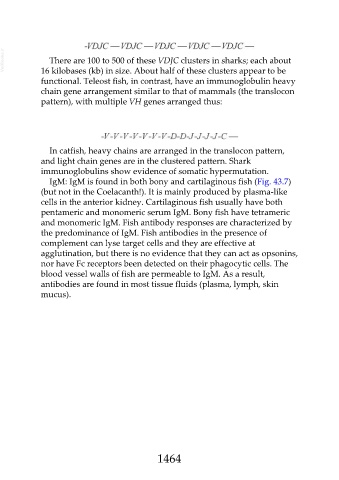Page 1464 - Veterinary Immunology, 10th Edition
P. 1464
VetBooks.ir There are 100 to 500 of these VDJC clusters in sharks; each about
16 kilobases (kb) in size. About half of these clusters appear to be
functional. Teleost fish, in contrast, have an immunoglobulin heavy
chain gene arrangement similar to that of mammals (the translocon
pattern), with multiple VH genes arranged thus:
In catfish, heavy chains are arranged in the translocon pattern,
and light chain genes are in the clustered pattern. Shark
immunoglobulins show evidence of somatic hypermutation.
IgM: IgM is found in both bony and cartilaginous fish (Fig. 43.7)
(but not in the Coelacanth!). It is mainly produced by plasma-like
cells in the anterior kidney. Cartilaginous fish usually have both
pentameric and monomeric serum IgM. Bony fish have tetrameric
and monomeric IgM. Fish antibody responses are characterized by
the predominance of IgM. Fish antibodies in the presence of
complement can lyse target cells and they are effective at
agglutination, but there is no evidence that they can act as opsonins,
nor have Fc receptors been detected on their phagocytic cells. The
blood vessel walls of fish are permeable to IgM. As a result,
antibodies are found in most tissue fluids (plasma, lymph, skin
mucus).
1464

